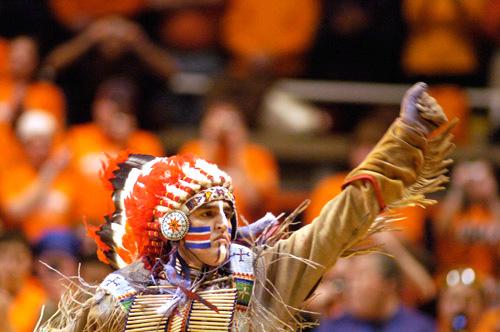The Last Dance (Video)

Dan Maloney, portrayer of Chief Illiniwek, performs the half-time dance. The Chief made his final perfomance Feb. 21. Beck Diefenbach
February 22, 2007
This is not Tyler Altenbaumer’s first time watching the Chief, but he doesn’t understand what is happening.
Coming up on three years old, Tyler has been to over a dozen games with his father, Brian. But this game is different. His father told him this would be the Chief’s last dance, but Tyler can not completely grasp the magnitude of the event.
To Tyler, halftime is entertainment. The Chief’s dance is something to fill the space between the end of the first half and the beginning of the second. Tyler’s father, a University graduate and Orange Krush member from 1991 to 1995, doesn’t even leave to go to the bathroom or to buy popcorn.
And on this day, he’s recording the event.
“It’s a pretty Orange and Blue family,” Brian Altenbaumer said. “The big thing for me (growing up) was getting to see the Chief at halftime.”
Get The Daily Illini in your inbox!
Like Brian, his son enjoys watching the Chief perform. But ten years from now, Tyler probably will not remember the Chief anymore than he will the outcome of the game. Still, Brian considered it important to bring his son to a late 8 p.m. game, a start time Tyler rarely sees.
“Because it’s the last time to see the Chief, we’re keeping him past his bedtime,” Brian said.
While the Assembly Hall jumbotron runs a montage of past Chiefs, Brian begins filming his son clapping in unison with the rest of the fans. He pans his camera to the court as the Chief enters. Reflections of camera flashes glisten on the floor around the Chief.
Tyler doesn’t understand the hundreds of students surrounding the edge of the court, stomping their feet and clapping their hands in matching rhythm, but he tries to mimic them. He doesn’t understand the folded arms during the middle of the routine, or even the tears in his mother’s eyes.
And Tyler doesn’t understand the man who bears the gaze of 16,618 sets of eyes, the man in the buckskin and bright orange feathers making his way in leaps and strides across the floor, but he likes him.
If Tyler doesn’t understand the spectacle before him, he might not understand why the occasion is both a joy and tragedy for those in attendance.
He doesn’t know who Stephen Kaufman or Lawrence Eppley are. He doesn’t know who Dan Maloney is. He doesn’t even know what a Board of Trustees does.
Words like honor and disgrace, symbol and mascot, mean nothing to him. He doesn’t know the outside pressures that have influenced this performance. He has no sense of soured relations between a University and its community.
He does know that the crowd was never this loud before halftime.
The Chief’s walk from mid-court to the tunnel — marked for years by a respectful silence — in its final rendition, is filled with the loudest applause of the night, an applause filled with cries of cheer and desperation from the crowd.
As halftime comes to an end, Tyler watches the Chief head off the court. In typical fashion, the Chief begins to exit between the folded arms of cheerleaders. But on this night he pauses, turns around, and strides back to center court.
Standing on the center tile, the Chief pays his respects to his adoring crowd by facing each direction, raising his hands to thank his audience.
Tyler watches the long, colorful headdress as it leaves, back through the cheerleaders, under the tunnel and out of sight.
The crowd was never louder.






